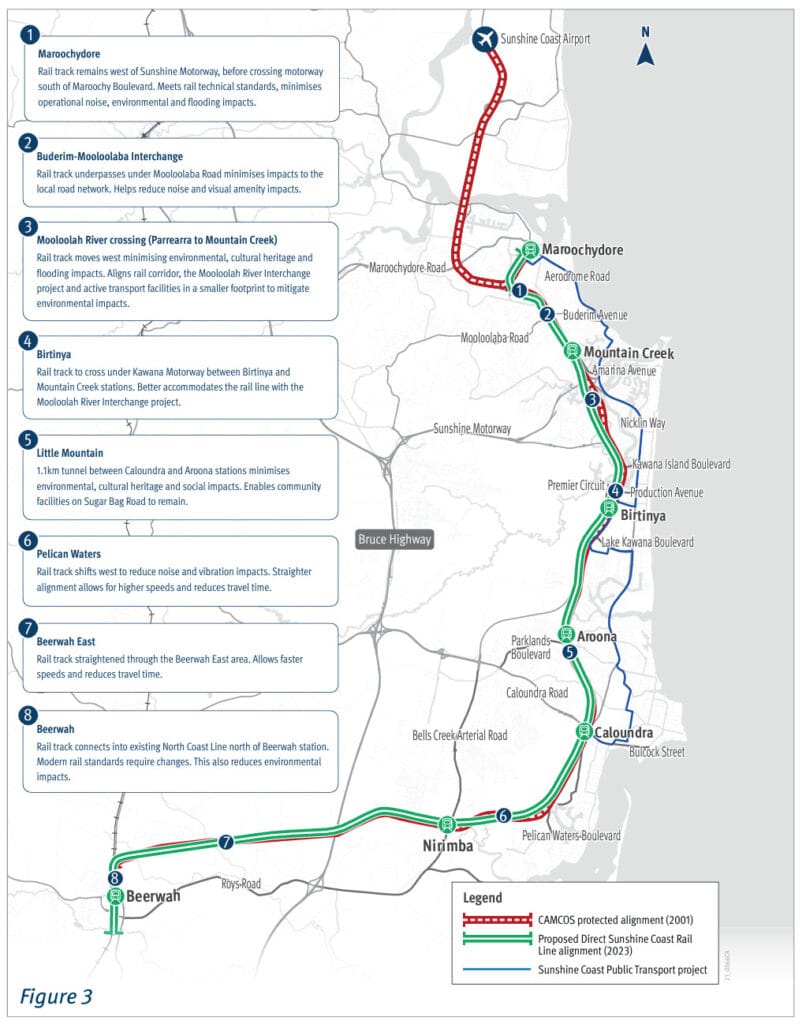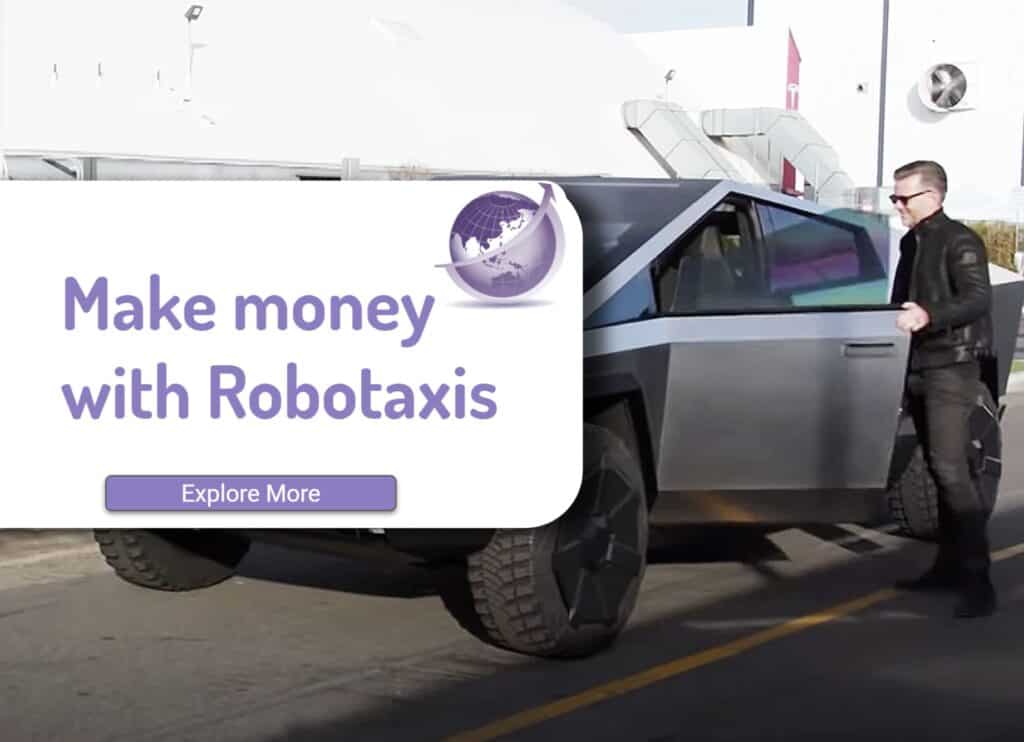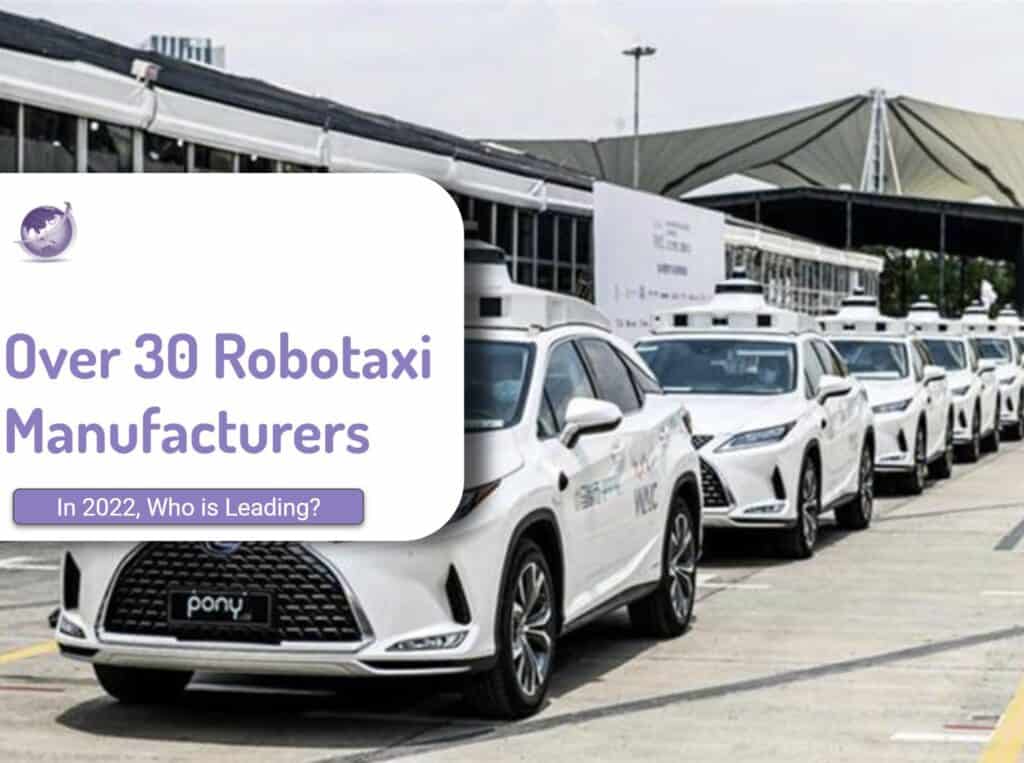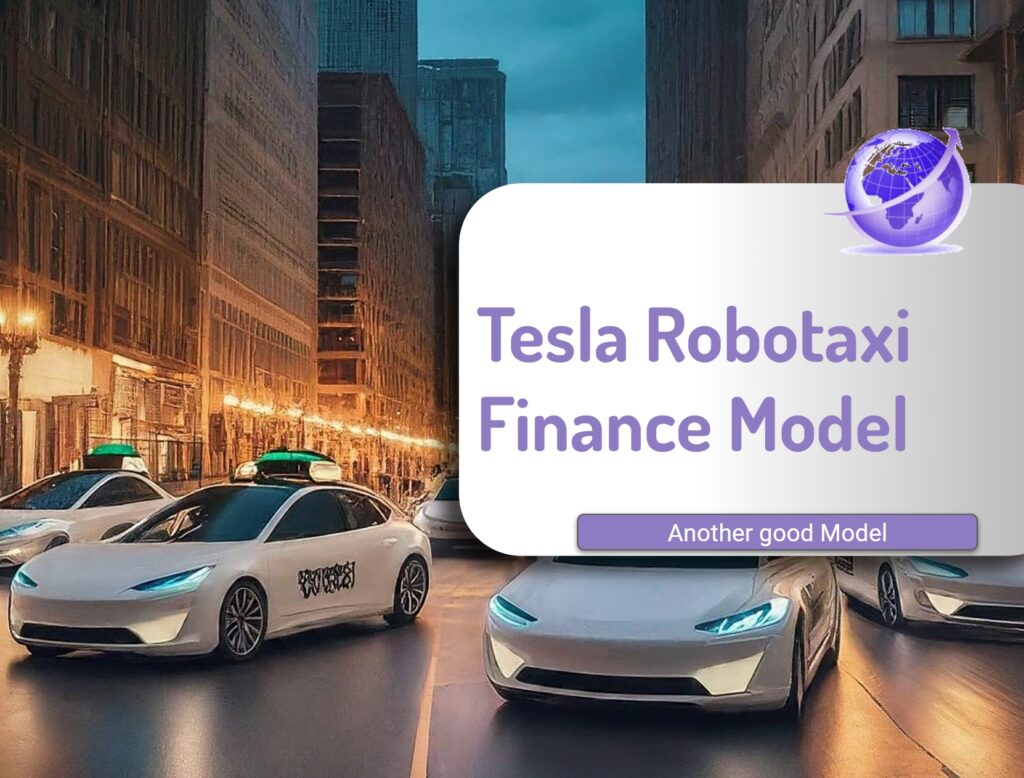A rail line from Brisbane to the Sunshine Coast has recently passed another step from idea to reality, but should we have robotaxis not rail for the Sunshine Coast. The Queensland State business case says rail will cost >$13 billion, up from $5 billion in just 3 years. The 100km trip from Sunshine Coast to Brisbane would be at least 45 minutes faster than a car. About 60,000 cars travel the Bruce Highway section daily – but only about 10% of the destination is the Sunshine Coast. The finished project would stop at only 7 stations – Nirimba, Caloundra, Aroona, Birtinya, Mountain Creek and Maroochydore. The Birtinya and Maroochydore section would benefit from “faster rail”, with trains able to reach speeds of 140kph on some sections. Note. More stations means slower trains. This hub and spoke travel will require travel up to 5km to the nearest station.
The Direct Rail Sunshine Coast (DRSC) has been in planning since 1994 with the Camcos land corridor reserved in 2001 so there is minimal land resumption needed. The project got multiple political signoffs, but nothing progressed.
Given the 2 decades, is heavy rail the best option for this transport corridor for less than 9,400 journeys per day (2040)? This current rail is contrasted using a fleet of autonomous vehicles, with an infrastructure for charging, maintenance and operating costs, utilising the existing roadways (with dedicated lanes) and providing “last mile” service. Autonomous vehicles were science fiction 25 years ago. Today, driverless robotaxis operate in multiple cities globally. Is it a valid option today?
Effective Public Transport
The design of public transport is complex with 4 elements. If any are missing, consumers choose private cars for the journey. Many public authorities want to increase active transport and use of public transport for various reasons: emissions, congestion, city planning and lifestyle. The Sunshine Coast Council has a goal to treble public transport. This train proposal is actually only for 6% of journeys made by local residents to work in Brisbane, or for holiday makers travelling to the Coast for short-term stays. Without the local transport solutions, the 400,000 residents will endure more congestion, more emissions and risk losing the lifestyle they moved to the Coast for.
- Available within 400 m (“the last mile”). On the Coast, most becomes too difficult – at both ends of the journey)
- No more than 8 minutes (or immediacy)
- Passenger safety
- Affordable
Conclusion
| Key Element | Trains DRSC | Robotaxis | Robotaxi vs Train |
|---|---|---|---|
| Capital Cost | $13 billion | $69.0 million | 180 times less |
| Operating Loss | -$30m | $9.0 million | Profit not loss |
| Start Date | 2032 | 2025 | Start 7 years earlier |
| Door to door | No | Yes | Ease of use |
| Frequency | 1 hourly | 10 minutes | On-demand |
| Service Area | Limited stations | Anywhere on Coast | Flexibility |
| Improvement in local journeys | no change | Provides local transport options | Local shopping / education transport |
Details of the Train Option
The business case demonstrated a BCR (Business Cost Ratio) of 0.3 to 0.4, A BCR less than 1 is negative, and would not normally proceed. The Queensland Government states the indirect social benefits of public transport make the project investable and committed funds to proceed. Note that the Federal Government still needs to double its contribution to the project for it to proceed.
Map of Trains Sunshine Coast

Stages And Costs For Rail
- Stage 1 $5.4b, 19 km dual track built from Beerwah to Caloundra, complete 2032 ($5.5b to $7b)
- Stage 2 $3b, 10km Caloundra to Birtinya – includes a tunnel under Little Mountain
- Stage 3. $3b, 8km Birtinya to Maroochydore city center.
- Construction starts in 2026.
- Support up to 2,000 jobs
- The Caloundra terminal is planned to be operational for the Olympic Games in 2032
- Staged delivery will see the line ultimately run to Birtinya and Maroochydore
- No timetable was offered for the train to Maroochydore.
- Each train carries a maximum of 720 passengers. Total passengers are forecast to be 9,400 by 2040.
Robotaxis not Rail for Sunshine Coast
An alternative option is to use autonomous electric vehicles sized from two to 30 passengers using existing roadways. It would presume there are dedicated lanes on both local and the Bruce Highway which would be dedicated for robotaxis and vehicles with more than four passengers per vehicle. For a full discussion see Autonomous Vehicles by 2023. The key to this proposal is that robotaxis operating cost are substantially less than cars. Moreover autonomous cars do not require a driver unlike taxi or rideshare. The cost of robotaxis is lower than any public mass transport globally can do (London Underground, Singapore etc).
Particularly important, autonomous vehicles are door-to-door, overcoming the last-mile barrier. In the train option, politicians and planners are concerned that the stations would become gridlocked parking lots and increase congestion on roads to and from stations. Stations were omitted from the train proposal due to the inability to use existing streets around other proposed stations.

Assumptions
This is a simple model. I have made the capacity similar to the train, 720 maximum capacity, and the forecast travellers of 9,400 per day by 2040 (16 years away). Robotaxis, with a dedicated lane and traffic signal improvement, could provide a 1.5 hour transit to the northern boundary of Brisbane. Using 2 passengers per robotaxi, the fleet would need about 300 robotaxis. This is for each direction, or a total of 600 (both directions). Robotaxis could be sized from small vehicles to mid-sized buses. Robotaxis could travel empty to adjust peak flow to or from Brisbane. Some of these journey destinations could be anywhere on the north of the Brisbane River (including the Airport) or deliver passengers to a train station in Brisbane such as Northgate. It would connect the Sunshine Coast University campuses at Sunshine Coast and Moreton Bay.
- Vehicles would be available 24 hours per day.
- Pickup from business or home within 8 minutes.
- Use the same vehicle the whole journey.
- Fixed price per vehicle to encourage ride sharing.
- At 300 taxis every 2 hours, means 4 robotaxis per minute, or on the Bruce highway 250 m apart.
- The fleet could provide local rideshare services when demand to and from Brisbane was low to provide improved services for local journeys.
- The fleet size can be rapidly adjusted to adapt to demand.
Capital Costs
- Assume a vehicle cost f $100,000 each
- Solar farm of 42MW to provide low cost electricity
- Battery and charging support
- Cleaning, maintenance services by a provider
- Painting of dedicated lanes from Sunshine Coast to Brisbane
- Upgrade of 20 traffic signals with smart passage.
- Using a smart App for transport as a service (such as Uber, GoJeck,, Grab,. DidI) for smart dispatch.
- First vehicle in mid-2025. (Based on regulation, not technology)
Conclusion
The table below lists key comparative aspects. Should the government invest in rail for a faster journey?
| Key Element | Trains DRSC | Robotaxis | Robotaxi vs Train |
|---|---|---|---|
| Capital Cost | $13 billion | $69.0 million | 180 times less |
| Operating Loss | -$30m | $9.0 million | Profit not loss |
| Start Date | 2032 | 2025 | Start 7 years earlier |
| Door to door | No | Yes | Ease of use |
| Frequency | 1 hourly | 10 minutes | On-demand |
| Service Area | Limited stations | Anywhere on Coast | Flexibility |
| Improvement in local journeys | no change | Provides local transport options | Local shopping / education transport |
Sunshine Coast Council Traffic Goals
Sunshine Coast Strategic Transport Plan (2018) dentified that less than 6% of journeys of Coast residences was to Brisbane. 85% of all journeys are by private car. Walking and cycling make up less than 12% of journeys (130,000 per day), less than 3% on public transport (40,000) and majority by car (1.17m journeys per day). Over 55% of households owned 2 or more cars – the second highest ownership in Australia. What the graphs show below is the Brisbane to Maroochydore is irrelevant to transport on the Coast.
Targets by 2040 is private vehicle reduction to 70%, active transport rise to 20%, and passenger transport rise to 10%. This rail project will provide little impact on these targets.

More Reading
- Multi-billion-dollar direct rail line to Sunshine Coast announced, but some say it’s not good enough for the Olympics ABC https://www.abc.net.au/news/2024-02-25/sunshine-coast-direct-railway-cameron-dick-bart-mellish/103509408
- Route and station details refined for heavy rail project as funding secured Dec 2023 https://www.sunshinecoastnews.com.au/2023/12/01/station-with-sea-views-plans-updated-for-rail-project/
- Why a heavy rail line can’t be built to Maroochydore in time for the Games Mar 2024. https://www.sunshinecoastnews.com.au/2024/03/10/costs-and-complexities-unveiled-for-heavy-rail/
- Direct Sunshine Coast Rail Line business case summary released Mar 2024
- Direct Sunshine Coast Rail Line https://www.yoursay-projects.tmr.qld.gov.au/direct-sunshine-coast-rail
- Business Case Detailed Summary TMR https://hdp-au-prod-app-qldtmr-yoursay-files.s3.ap-southeast-2.amazonaws.com/9517/0971/7651/Detailed_business_case_summary_March_2024.pdf
- Sunshine Coast integrated transport strategy 2018 https://www.sunshinecoast.qld.gov.au/Council/Planning-and-Projects/Council-Strategies/Sunshine-Coast-Integrated-Transport-Strategy
Appendix 1- Summary Costings
To access the Google Doc spreadsheet click here
| Train | Capital Costs | |
| Train Capital Cost | $13,000,000,000 | |
| Cost Overrun | 20% | Fat-tailed risk of 1.5 |
| Operating Costs Annual | ||
| WCC | 5% | Govt funs |
| Lifetime of Plant | 30 | |
| Depreciation Cost | $650,000,000 | |
| Cost of rail operations | $63,072,000 | Estimated $40.92 in 2021/2022 (https://greens.org.au/qld/publictransport) |
| Utilisation | 40% | Average between peak and offpeak |
| Ticket Price | 20 | Average single journey |
| Trains per day | 15 | Hourly 5am to 11pm |
| Passengers PA | 1,576,800 | 9,400 pd in model by 2040 |
| Passenger fares | $31,536,000 | |
| Robotaxis | ||
| Number | 600 | |
| Purchase price | $100,000 | Used or new Tesla 3, Y, Cybretruck, or Model 2 +FSD |
| Total capital | $60,000,000 | |
| Electricity Supply | ||
| Energy Used | 60 | kWh Journey 240km |
| Days of year | 365 | |
| Journeys per day per vehicle | 5 | 2 hours each way |
| Total energy | 300 | kWh per vehicle |
| Fleet total energy | 180,000 | kWh per day |
| Solar and Charging | ||
| Panels Needed | 42,857 | MW (Solar constant 4.2 hrs per day) |
| Cost of Panels | $17,857,143 | $5,000 per 10kW, $5m per MW |
| Battery | $20,000,000 | $2 m per MWh 10Mh |
| Total Batteries + solar | $37,857,143 | |
| Plus Chargers | $120,000 | Indicative Tesla $US91,000 |
| Chargers | 50 | |
| Chargers cost | $6,000,000 | |
| Solar + Charging | $43,857,143 | Total PV, batteries and Chargers |
| Roadworks | ||
| Lane marking | $2,000,000 | |
| Signal updates | $4,000,000 | |
| Maintenance Electricity | 10% | |
| Depreciation Vehicles | 20% |






